What are Rheometry and Rheology?
TA Blog Team
January 31, 2022
Whether researchers are optimizing the texture of yogurt or studying adhesive’s curing, rheometry helps us understand materials and predict their behavior. Rheometry measures the amount of deformation a material or liquid undergoes when a force is applied. The combination of stress, strain and shear behavior forms the basis of rheology, the science of the deformation of materials.
Using rheometry experiments to study the rheology of materials is a key part of the materials characterization process. For fluids in particular, understanding and predicting the rheology of a sample can be incredibly complex. Often, a sample’s behavior varies depending on the magnitude of the forces applied, meaning rheometry usually has to be used to measure the rheology of samples as these properties are too difficult to predict reliably.1

Measurements
Rheometry measurements are performed using a rheometer Depending on the type of rheometry, different designs of rheometers can be used, from acoustic extensional rheometers to cone and plate shear rheometers.
The rheometer applies a force to the sample and the resulting stress or strain is measured using a sensor device, such as a transducer or a displacement sensor. Some rheometers can be interfaced with computers for automated calculation of stress and strain factors from the measured forces to simply rheometry analysis.
Rheometry typically determines the viscosity or viscoelasticity of a material. Viscosity measures the amount of flow resistance caused by internal friction and depends on the microscopic properties of the system, such as particle size.2
Viscoelasticity measures the material properties in response to a deforming force. In a purely elastic material, there is no dissipation of energy after a load has been applied, but in viscoelastic materials there is some hysteresis in the stress-strain behavior due to the deformation of the material. All of these properties are key parts of a rheometry study.
Applications
TA Instruments
TA Instruments is a world expert in rheometry instruments, offering a line of top-of-the-range rheometers, including the Discovery Hybrid Rheometer and the ARES-G2.3
The Discovery Hybrid Rheometer is designed to be an incredibly versatile platform for rheometry. It boasts TA Instruments’ patented advanced drag cup motor, magnetic bearings, a force rebalance transducer and a True Position Sensor, all in a single-head hybrid device. This means it can perform direct stress and strain control measurements as well as regular force measurements. With a wide range of accessories, the Discovery Hybrid Rheometer also comes with the Smart Swap™ system for automatic detection and identification of devices to streamline your measurements.
The ARES-G2 is TA Instruments’ most advanced rotational rheometer offering unparalleled data accuracy and strain and stress control, leading to its recognition as the industry standard for rheological measurements. The ARES-G2 has become a highly valued, popular tool for research and material development. The ARES-G2 remains the only commercially-available rheometry equipment capable of performing independent shear stress and normal stress measurements, which can be achieved with a number of dedicated actuators for different test types.
The ARES-G2 rheometer also benefits from TA Instruments’ Smart SWAP technology for industries and research using multiple types of rheometry measurements or working with different sample types. This highly accurate rheometer is also enhanced by software analysis packages that allow for advanced Fourier Transform Rheology Analysis and Large Amplitude Oscillatory Shear assessments.
Contact TA Instruments today to find out how our devices can revolutionize your rheometry measurements.
References:
- Hou, Y. Y., & Kassim, H. O. (2005). Instrument techniques for rheometry. Review of scientific instruments, 76(10), 101101.
- Snoeijer, J. H., Pandey, A., Herrada, M. A., & Eggers, J. (2020). The relationship between viscoelasticity and elasticity. Proceedings of the Royal Society A: Mathematical, Physical and Engineering Sciences, 476, 20200419.
- TA Instruments (2021), Rheometer, https://www.tainstruments.com/products/rheology/discovery-hybrid-rheometers//, accessed January 2022
Other Resources
- Applications Note – Texture of Yogurt
- Applications Note – Adhesive’s Curing
- Webinar – Strategies for Rheological Evaluation of Adhesives
- Webinar – Applications of Tribo Rheometry in Material Characterization
- Webinar – Rheology Workflow Automation with TRIOS AutoPilot: Enhanced Measurement with Reduced User Training
- Webinar – Use of Thermal Analysis and Rheometry to Study Waxation in Crude Oil
- Webinar – Thermal, Rheological and Mechanical Characterizations of Thermosets
- Instrument – Discovery Hybrid Rheometer
- Instrument – ARES-G2
- Contact – Contact TA Instruments Today

